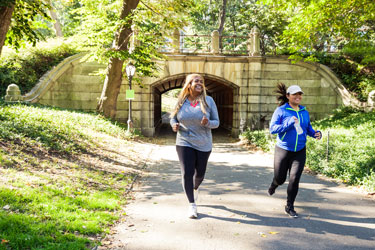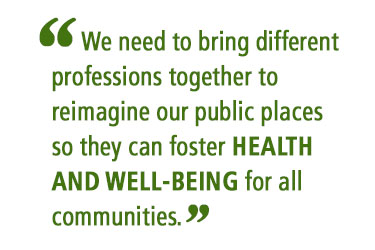The connection between parks and public health has long been recognized. Natural spaces can encourage physical activity, bolster mental health and nurture community connections. During the COVID-19 pandemic in the U.S., parks have played an especially important role, helping people to safely relax and gather.
In April, the National Association for Olmsted Parks launched Olmsted 200, a year-long celebration marking the bicentennial birthday of renowned landscape architect Frederick Law Olmsted. APHA is one of 10 founding partners of the Olmsted 200 campaign, which is building public and policy support for natural spaces in the U.S. Olmsted was an early member of APHA, leading a committee on "the sanitary value" of parks and nature.
Anne Neal Petri, president and CEO of the National Association for Olmsted Parks and managing partner of Olmsted 200, discusses Frederick Law Olmsted’s legacy and the importance of public parks today.
Who was Frederick Law Olmsted and what role did he see for parks in American life?
Frederick Law Olmsted designed hundreds of parks coast to coast, starting with Central Park in 1858. It wasn’t until age 43 that he embraced landscape architecture as his profession. He was a farmer, an investigative journalist for The New York Times, first executive secretary of the U.S. Sanitary Commission, a conservationist and proponent of national parks.
He’s known as the founder of landscape architecture, but Olmsted was really a visionary social reformer. He saw how wealthy people could get away from the urban centers to enjoy private land but poor people could not, how people had no place to come together in a time of civil war when there were deep social divisions. He was very committed to the idea that parks and public spaces belong to all people.
Olmsted believed that parks should be safe and enjoyable, free of distraction and feature restful scenery to help unbind people from their stress. He wanted parks to be gathering places for all walks of life, places where everyone was on the same footing to enjoy active and passive recreation. Equity and access were central to his philosophy and certainly should be central today.
How did public health considerations factor into Olmsted’s work?
When it came to the designs and the concept of Olmsted’s parks and open spaces, he was thinking public health even before there was a public health association. In the late 19th century, America was in a public health crisis, with open sewers, nonexistent sanitation, widespread disease, crowded living conditions, pollution and environmental degradation.
Olmsted was faced with the challenges of a rapidly urbanizing country and governments that turned a blind eye to the public’s health. He saw the connection between public health and a thoughtful built environment. It’s what motivated so much of his urban park design. He viewed these not just as pretty places, but also as an antidote to urbanization and poor health.
Parks help moderate temperatures, reduce pollution, address stormwater issues, provide habitat for birds and other wildlife, offer opportunities for physical exercise and are critical to helping us address the effects of climate change. Having access to parks and public spaces is shown to reduce rates of asthma and heat-related illness. And physical activity fights cardiovascular disease, Type 2 diabetes and cancer.
Do you believe that Olmsted’s vision is relevant today?
Olmsted’s ability to see the intersection of social, civic and environmental well-being is amazing. We’ve gotten away from that, though. Not everyone has access to or is comfortable in our public spaces, and that is, itself, a public health problem. We need to bring different professions together to reimagine our public places so they can foster health and well-being for all communities the way Olmsted envisioned. 
We also need to engage the communities that surround these spaces in the decisionmaking process. The pandemic has helped us revisit the importance of public space to our well-being as so many of us sought refuge in the outdoors. But certain populations are less likely to have access to opportunities for physical activity and are more likely to be exposed to environmental pollutants.
One of the goals of Olmsted 200 is to try to educate the American public about how critical parks and public spaces are to our physical and mental health. Parks are essential public infrastructure, and the principles that inform their design — democratic spaces, physical and mental health, community — should govern their creation and maintenance.
How can we elevate the importance of parks and public spaces for all?
We need more investment in parks, especially in underserved communities — long-term, sustainable funding. Regrettably, parks and public spaces are at the bottom of the list when it comes to resources. We have to do a better job. We feel that parks are essential public infrastructure, that they are not a luxury, which is often how they are perceived. Knowing the health benefits that access to these parks can provide, it’s crucial that we have resources behind them.
A number of Olmsted 200 partners have gone on record in support of the Parks, Jobs and Equity Act to provide more extensive and permanent funding of parks. Our website, Olmsted.org, offers webinars for parks officials to help them apply for funding that exists already. Parks are not self-sustaining.
We need stewardship to care for these spaces over the long term. Olmsted 200 is all about showing people the value and importance of equitable, accessible parks and public spaces. We have resources and toolkits and a national calendar of events in parks and landscapes across the country and hope everyone will take part.
Learn more about public health benefits of parks from APHA’s Kate Robb, MSPH, and about healthy community design from APHA.
Photo: Two women run in New York City’s Central Park, one of the many public parks designed by landscape architect Frederick Law Olmsted. Photo by LeoPatrizi, courtesy iStockphoto.